Special Occupancies
Restaurants and Cafeterias [5]
General [5.1]/ Access Aisles [5.3]
Access is required to 5% of fixed or built-in tables distributed throughout dining areas. The required clear width (36 inches minimum) is specified for the clearance between the edges of fixed tables or between table edges and walls. Recommendation: Consider providing additional clearance so that routes remain accessible at occupied tables. Space should also be available so that people using wheelchairs do not obstruct required exit and circulation routes. This also allows additional space for wheelchair maneuvering to and from tables.
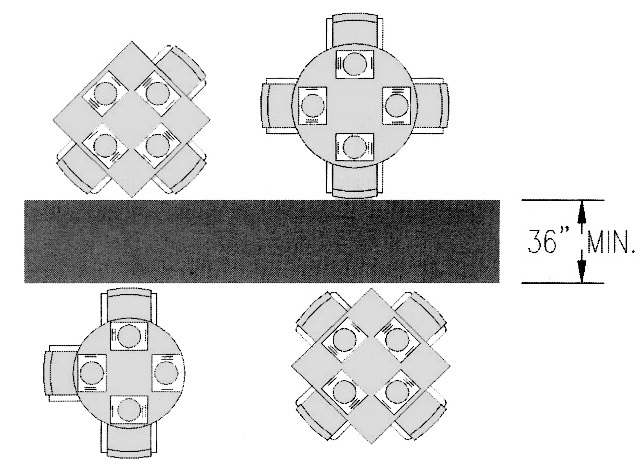
Counters and Bars [5.2]
A "portion" of counters where food or drink is consumed must be accessible or service must be available at accessible tables in the same area. Counters where food or drink is sold or distributed but not consumed can be treated as sales and service counters, which are addressed in 7.2.
| Types of Counters | Maximum Height | Minimum Length | Knee Clearance (forward approach) |
| Dining/Bars (service) | 34 in | 60 in | required |
| Dining/Bars (no service) | 34 in | not specified (consider 60 in) | required |
| Food Service (tray slides) | 34 in | full length | optional |
| Sales/Service | 36 in | 36 in | optional |
Dining Areas [5.4]/ Raised Platforms [5.7]
Since accessible seating must be dispersed throughout new facilities, it is important that an accessible route be provided to all raised or sunken dining areas, outdoor seating areas, loggias, etc. (An exception is allowed for mezzanines that accommodate no more than a third of the seating area in buildings without elevators). Platform lifts can be used at raised platforms that serve a head table or speaker's lectern but not other dining areas except where existing constraints make ramp (or elevator) access infeasible.
Food Service Lines [5.5] and Tableware and Condiment Areas [5.6]
Tray slides, if provided, must be no more than 34 inches high. Self-service shelves and dispensers must be within allowable reach ranges. Additional shelves or those where service is available can be located beyond these ranges. Pass-through space at service counters can provide easier access.
Salad Bars and Buffet Counters
Recommendations: The standard reach range should be considered in the design of built-in salad bars although not all portions are required to be within this range (food layout and suitable utensils are also factors). Since it can be difficult to maneuver a wheelchair while balancing plates of food, tray or plate slides can greatly facilitate access but their effect on reach should be taken into account.
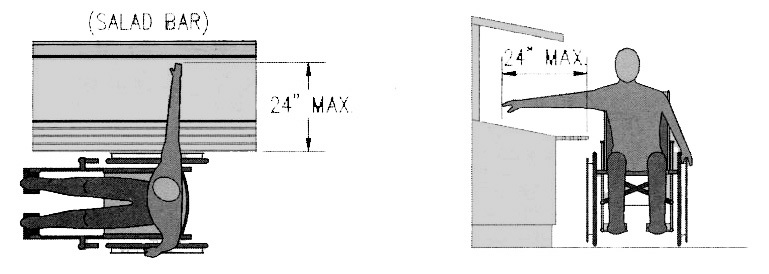
Vending Machines and Other Equipment [5.8]
Since vending machines often are not fixed, ADAAG only requires that clear space be available at them for a forward or side approach and that they be on an accessible route. Recommendation: It is recommended that the operable portions be within accessible reach ranges.
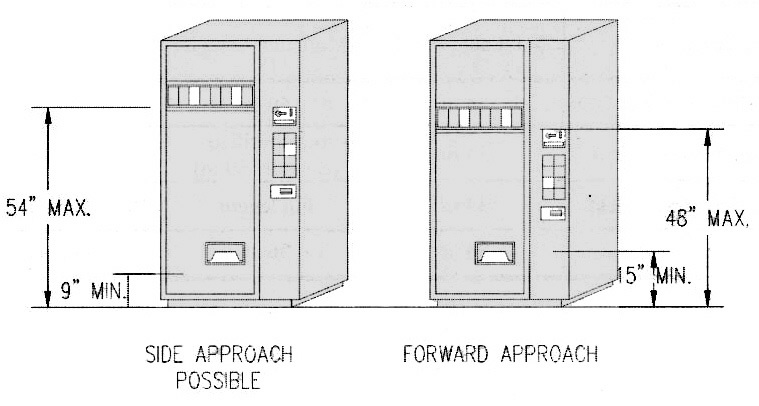
Medical Care Facilities [6]
Section 6 covers access to patient bedrooms and applies to "medical care facilities" which are defined in part as those providing overnight stay. Those that do not, such as doctors' offices and outpatient facilities, are subject to other requirements of ADAAG. The facilities listed in section 6.1 are provided as examples of the three scoping categories. Other facilities not listed should be treated according to the examples they most closely resemble. The types of services provided and the characteristics of the intended population are often key in determining which scoping category to follow.
General
Because many patients in a medical care facility may experience reduced mobility during their stay, at least 10% of patient bedrooms and in-room bathrooms must be fully accessible. This category covers those facilities where the need for access is not likely to exceed the norm among medical occupancies. Examples include general purpose and pediatric hospitals, obstetric units, substance abuse treatment centers, and most mental health care facilities. All public use and common use areas are required to be fully accessible.
Hospitals and Rehabilitation Facilities Specializing in the Treatment of Conditions Affecting Mobility
Access is required to all patient bedrooms and toilet rooms in facilities or units within that specialize in treating conditions that affect mobility. This includes not only people who use wheeled mobility aids, but also those who may walk with difficulty or use walkers, canes, crutches, braces, or prostheses. Consideration must be given to the various conditions that affect mobility such as:
-
arthritic, neurological, or orthopedic conditions
-
respiratory diseases that require use of portable oxygen
-
cardiac conditions that impose significant functional limitations
It may be necessary to weigh the degree to which a facility specializes in treatment of such conditions over others, but careful consideration of the need among the intended population is key. Examples include orthopedic hospitals, physical rehabilitation facilities, and spinal cord or traumatic brain injury treatment centers. Scoping can be applied on a pro rata basis to portions of a facility where only certain units or departments provide such treatment.
Long Term Care / Nursing Homes
Definitions of "long term care" in health regulations, building codes, and accreditation standards can be used as a guide to determine in which facilities 50% of the patient room are required to be accessible. (ADAAG does not define the term). The degree of medical treatment or care provided at a facility may need to be taken into account since this section is not intended to cover facilities that provide residential but little or no medical care. Many facilities offer a combination of services, in which case accessibility requirements may be applied to different parts of the complex. New multi-unit residential facilities are covered by the Fair Housing Amendments Act; information regarding requirements is available from the Department of Housing and Urban Development (HUD).
Dispersion
Accessible bedrooms should be dispersed among all units or departments providing overnight stay and among different classes of rooms (private, semi-private, etc.). Industry practice and needs assessment can be used to further determine the distribution. For example, a greater number might be located in general surgical units than in pediatric and obstetric wards. Different units may be subject to different scoping requirements, such as an orthopedic wing (where 100% of patient rooms are required to be accessible) within a general hospital (where only 10% of patient bedrooms must be accessible).
Alterations / Additions
The minimum number of accessible patient rooms required is based on the total number of bedrooms that are altered or added, including where a unit or department is completely renovated. In partial renovations of a unit or department, altered bedrooms must be made accessible according to the number required in new construction unless that number is already met (either within that unit or in other parts of the facility).
Doors
The exception from latch-side maneuvering clearances is allowed only at acute care bedrooms, not throughout a hospital. Recommendation: Compliance with 4.13.6 is recommended because while wider door openings may facilitate access, they do not fully compensate for latch-side clearance, particularly on the pull side.
Bedside Clearances
Clearance at least 36 inches wide is required on each side of beds. Where more than one bed is provided, this space can overlap. Privacy curtains or screens that can be easily moved out of the way can also overlap this clearance. T-shaped space can be provided within bedside clearances. Turning space (60 inch diameter circle) is recommended between beds to allow additional maneuvering and transfer space.
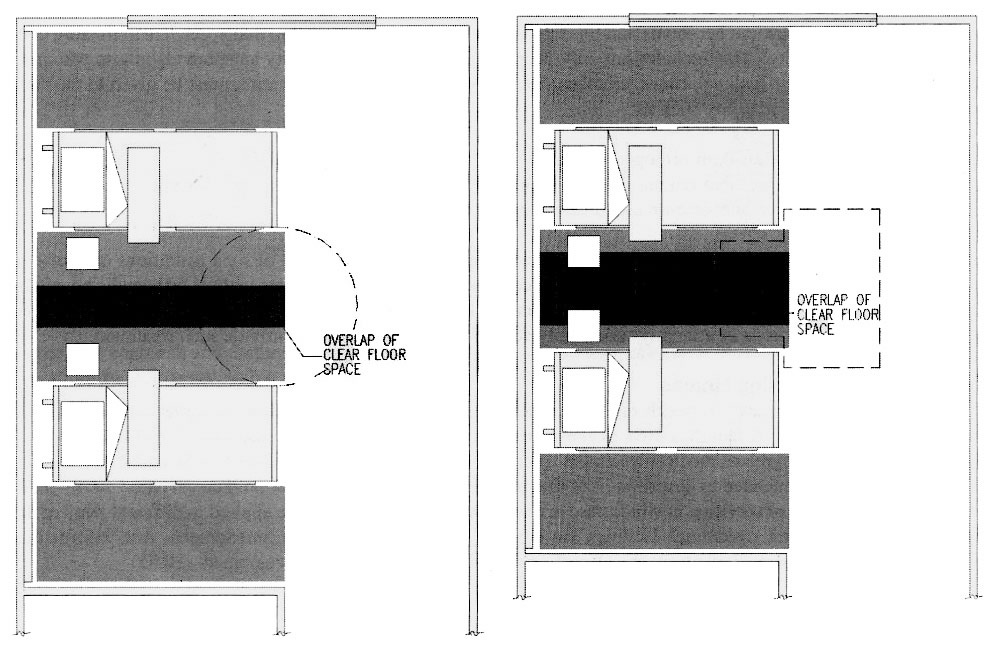
Controls and Equipment
Access requirements apply to fixed controls and operating mechanisms intended for independent use by patients. Equipment and controls used by staff are not required to comply although access (or adaptability) may be advisable in some cases so that employees with disabilities can be more easily accommodated.
Patient Toilet Rooms [6.4]
ADAAG specifications are based on the independent use of toilet and bathing facilities and do not address alternate designs for assisted use. Requirements for both independent and assisted access can usually be met in facilities where ADAAG applies to a portion (10% or 50%) of patient bedrooms. Where all patient bedrooms (and toilet rooms) must comply, alternatives to certain ADAAG specifications may be possible as an equivalent facilitation, as permitted in 2.2. Any considered departures should be based on a careful assessment of:
-
the needs of the intended population
-
the degree to which an ADAAG specification and a preferred design conflict
-
the feasibility of designs that can accommodate both independent and assisted access
Business and Mercantile [7]
Sales Counters [7.2(1)]
In providing access to each "type" it is necessary to consider counters where only certain transactions can be made such as refunds for example, or counters that exclusively serve specific departments or areas of a sales floor exclusively. Recommendation:Travel distances between counters and facility size should be considered where not all counters are accessible. (ADAAG does not specify maximum travel distances).
Other Counters/ Teller Windows [7.2(2)]
Alternatives to 36-inch high counters (lowered portions, folding shelves) are recognized since other design considerations (security, use by standees) may make a higher surface preferable. These alternatives provide an accessible writing surface at counters and windows used for banking, registration, payment, and other purposes. Where multiple teller windows or service areas are provided, such as in bank lobbies, consider access to each one. This eliminates operational considerations for convenient access where single queues form or where only a portion of windows or stations are staffed. At counters designed mainly for handing materials back and forth where the need for a writing surface by customers is unlikely (concierge desks, deli counters, etc.), pass-through space alongside counters can suffice. Fixed elements for public use, such as service buzzers and ticket number dispensers, need to be within accessible reach ranges and on an accessible route.
Sales and Service Counters, Teller Windows, Information Counters [7.2]
ADAAG generally specifies accessible counter heights up to 34 inches [4.32] but allows a height up to 36 inches for counters and service windows in business and mercantile occupancies because public use is limited to brief activities, such as writing a check, signing a receipt, or passing merchandise over the counter.
Check-Out Aisles [7.3]
Access is required based on facility size and the number of check-outs of each design. For facilities with less than 5,000 square feet of selling space, at least one check-out aisle must be accessible.
| Facilities with at least 5,000 sq ft of selling space | |
| Total of Each Design* | Minimum Accessible of Each Design |
| 1‒4 | 1 |
| 5‒8 | 2 |
| 9‒15 | 3 |
| 0ver 15 | 3 (+ 20% of total above 15) |
| *e.g. belt length or no belt, express or cash only, ect. | |
Clear passage must be at least 36 inches wide continuously and 32 inches at a point (24 inch maximum distance). Access can be provided at aisles shared between two check-outs. Access is also necessary at aisles used for exit only (but not check-out). Transaction machines and writing shelves located at accessible aisles should be within reach and usable from wheelchairs. Operable controls, including card swipes, must be with maximum reach heights (54 inches for a side reach, 48 inches for a forward reach). Writing surfaces must be 36 inches maximum from the floor. Recommendations: Adjustable features, such as shelves that can rotate out and machines that can be adjusted for optimum viewing from standing and seated positions will enhance access for the widest range of users. Consider that the standard eye level range of an adult seated in a wheelchair is 43 to 51 inches from the floor.
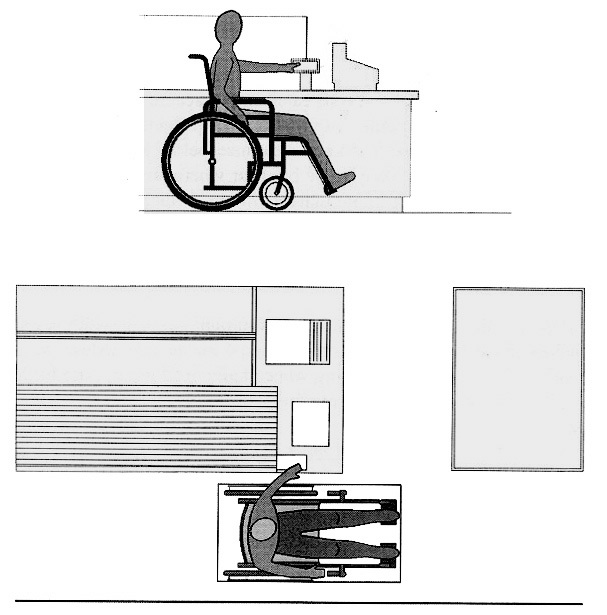
Security Bollards [7.4] and Security Devices
Bollards and rails used to keep shopping carts on the premises must allow an accessible clear passage (32 inches wide minimum) along at least one route for entry and exit. Alternative entries and accessible gates [4.13.3] can be used as long as they are not less convenient than other routes. For example, gates allowing wheelchair access cannot be locked or alarmed during times when the general public has unhindered access to the facility.
Inventory Control Devices
It is important that inventory control or security devices not obstruct required maneuvering clearances at doors. A minimum 12 inch clearance is required on the push side of swinging doors when the door has both a closer and a latch. This clearance is often useful at exterior doors without latches in countering the force of closers and wind resistance. When doors are automated, maneuvering space is not required.
Libraries [8]
Reading and Study Areas [8.2]
Access is required to at least 5% of fixed tables and study carrels. Recommendation: Specifications in 4.32, including clear passage for accessible routes, knee clearances and surface height (34 inch maximum) should be considered for movable furnishings as well.
Check-Out Areas [8.3]
Check-out counters at accessible lanes are held to a maximum surface height of 36 inches. Also required:
-
an alternative route at turnstiles
-
accessible gates [4.13.3] on accessible routes
-
access through (or around) book security devices (see page 135)
Card Catalogs and Magazine Displays [8.4]
Specifications are provided for magazine racks and card catalogs but access is also important at computer terminals available to the public for library searches and other information. Requirements for fixed counters and tables [4.32] specify a surface height (34 inches maximum) and knee clearance below appropriate for extended use as a writing/work surface. Where the period of use is likely to be brief, or where standees are to be accommodated as well, requirements in 7.2 for sales and service counters (36 inch maximum surface height, knee and toe space for forward approach optional) may be appropriate as an alternative. The preferred maximum reach height for card catalogs is 48 inches (recognizing that users may be lifting or manipulating card drawers).
Stacks [8.5]
Elements fixed to stacks, such as ladders, cannot reduce the minimum passage width nor should signs or other elements between 27 to 80 inches above the floor project more than 4 inches into aisles. Recommendation: Consider accessible circulation around stacks so that people using wheelchairs need not backup for long distances. T-shaped turning space will provide space for wheelchair maneuvering.
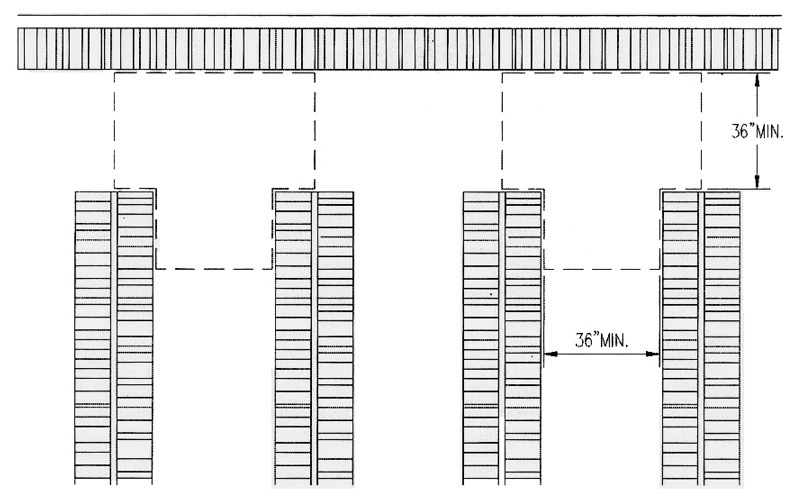
Recommendation: Dimensions for turns around obstructions in 4.3.3 (ADAAG Figure 7) provide minimum space for maneuvering around stacks where a cross aisle at the end of stacks is not provided.
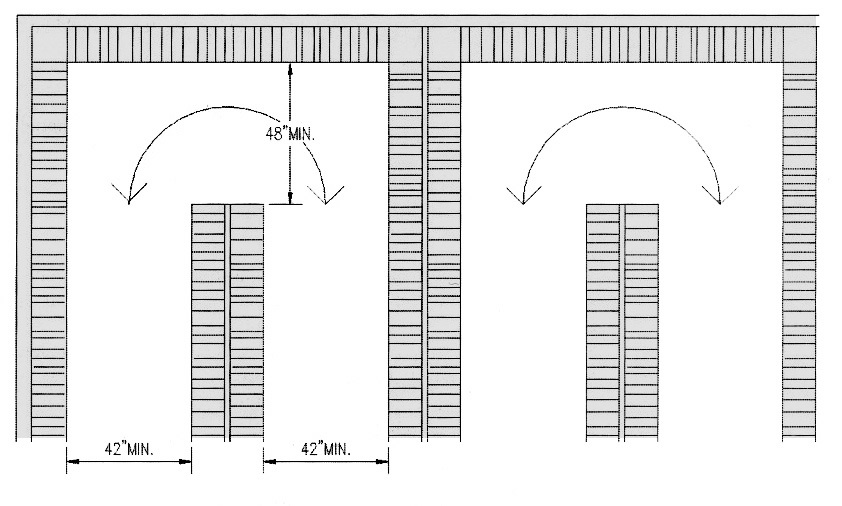
Accessible Transient Lodging [9]
Section 9 covers a range of facilities that provide sleeping accommodations but that are not used as permanent residences. Examples noted in the section (hotels, motels, resorts, dormitories, homeless shelters, and halfway houses) are meant to be illustrative and do not represent all types of lodging used on a transient basis.
In the case of the private sector, other types of residential facilities, such as apartment buildings, are not subject to the ADA (except for places of public accommodations within them, such as rental or sales offices). Note that distinctions made for purposes of ADA coverage do not coincide with building code classifications of "residential" occupancies. The Department of Justice provides technical assistance and guidance concerning the classification of "transient lodging." Housing constructed or altered by or on behalf of state or local governments is required to be accessible under the ADA (title II). Access to housing in either the public or private sector is also required by the Fair Housing Amendments Act of 1988.
General [9.1.1]
ADAAG applies to all public and common use spaces, such as hallways, corridors, and lobbies. ADAAG requirements include specifications for protruding objects in 4.4 and for signage in 4.30. Wall-mounted objects, such as light fixtures, must be selected and mounted so they do not pose a hazard to people with vision impairments. Objects with leading edges above 27 inches and below 80 inches above the floor cannot project more than 4 inches unless there is a tactile cane detectable cue below the object. Where room numbers are provided, they must be raised and Brailled and located on the wall at the latch-sides of doors for safety and uniformity. (Redundant room numbers and additional information not required to be tactile can be placed on the face of doors).
Minimum Number [9.1.2 and 9.1.3]
The number of accessible rooms required is based on the total number of rooms provided. Dispersion of accessible rooms among different classes (based on size, cost, amenities, etc.) is necessary. Rooms with combination roll-in/transfer showers are required in transient lodging facilities with more than 50 rooms. The number of rooms with this type of shower must be added to the basic number of accessible rooms permitted to have an accessible tub or shower. Accommodations for people with hearing impairments are required in a portion of guest rooms, including all those that provide access for people with mobility impairments.
For example, a transient lodging facility with 100 guest rooms must have at least 5 accessible rooms, 1 of which provides a combination roll-in/ transfer shower. These rooms must also provide visual appliances for people with hearing impairments. In addition, at least 4 rooms must be equipped with visual appliances for people with hearing impairments; these rooms are not required to be wheelchair accessible.
| NOTE *minimum door clearance required in all sleeping rooms and suites | ||
| FACILITY TOTAL | VISUAL APPLIANCES ONLY Total |
MOBILITY ACCESS & VISUAL APPLIANCES Total (portion of total with roll in showers) |
| 1‒25* | 1 | 1 |
| 26‒50 | 2 | 2 |
| 51‒75 | 3 | 4 (1) |
| 76‒100 | 4 | 5 (1) |
| 101‒150 | 5 | 7 (2) |
| 151‒200 | 6 | 8 (2) |
| 201‒300 | 7 | 10 (3) |
| 301‒400 | 8 | 12 (4) |
| 401‒500 | 9 | 14 (5**) |
| 501‒1000 | 2% of total | 2% of total (**) |
| Over 1000 | *** | ***(**) |
| *EXEMPT: Facilities with 5 or less rooms for rent also used by the proprietor as a residence, but that do not serve as a homeless shelter, halfway house, transient group home, or other social service establishment. ** 4 + 1 for each 100 over 400 *** 20 + 1 for each 100 over 1000 |
||
Classes of Sleeping Accommodations [9.1.4]
Accessible sleeping rooms and suites must be dispersed among the various classes of sleeping accommodations available according to factors such as room size, cost, amenities provided, and the number of beds provided. The objective of dispersion is to give people with disabilities the same range of options that others have in staying at a place of lodging. However, where the different classes or types of sleeping accommodations is greater than the minimum number of rooms required to be accessible by the table, this does not mandate an increase in the number of accessible rooms that must be provided. In this case, operational practices may compensate. For example, if a person requests an accessible room with one bed, but the only accessible room is one with two beds (usually let at a higher rate), leasing the larger room at the lower rate can satisfy the requirement for a choice of room prices.
Alterations to Accessible Units, Sleeping Rooms, and Suites [9.1.5]
The minimum number of guest rooms required to be accessible in an alteration is based on the total number of guest rooms altered. This is required for all future room alterations until the total number of each required to be accessible for the facility overall is met. Recommendation: While the minimum number is based on the total number of sleeping rooms altered, it is recommended that the number be based on the total number of sleeping rooms provided where the intended scope of work allows the opportunity to do so.
Bedside Clearance [9.2.2(1)]
Where one bed is provided in a room, maneuvering space at least 36 inches wide is required on both sides of the bed. If two beds are provided, this maneuvering space is required only between the beds. Note that the requirement for an accessible route to accessible elements and spaces may result in a 36 inch clearance on the other side of double beds nonetheless.
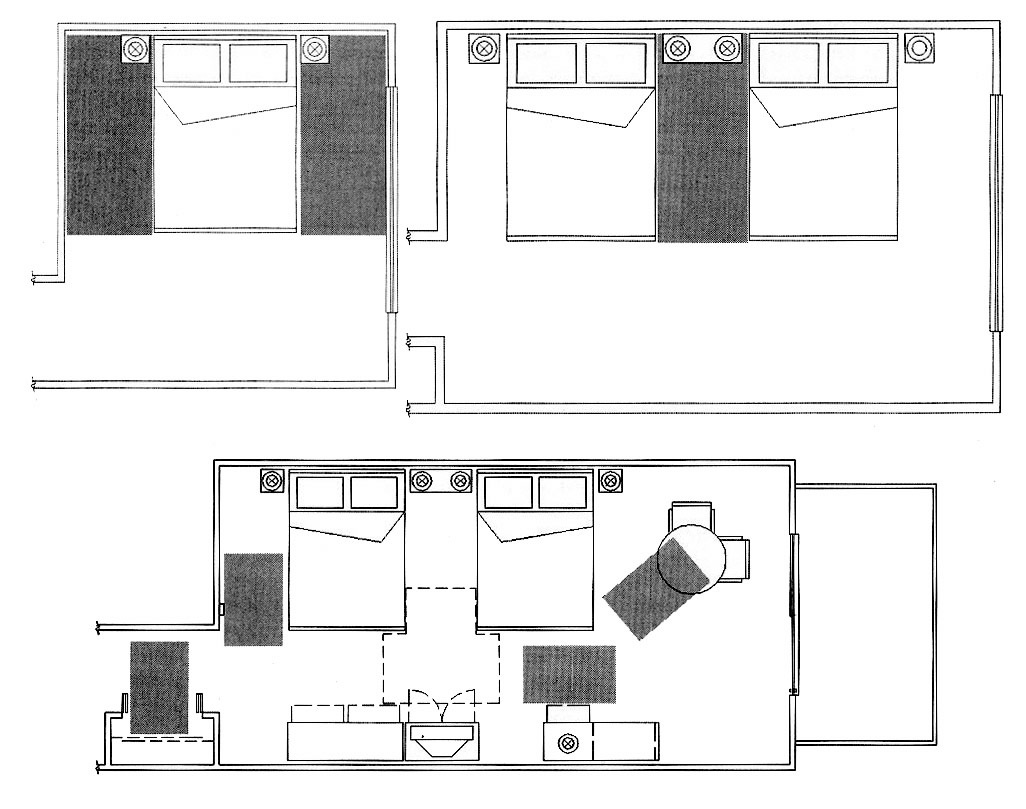
Clear floor space is required at accessible controls and elements (e.g., thermostats), storage facilities (e.g., closets), and should be provided at non-fixed furnishings (e.g., dressers, tables). An accessible route must connect with the clear floor space. Turning space can overlap required clear floor space, including bedside clearances.
Accessible Route [9.2.2(2)]
An accessible route at least 36 inches wide must be provided to all accessible elements, including phones and thermostats, provided for use by room occupants, fixed or built-in storage facilities required to be accessible (closets, drawers, cabinets), and other spaces required to be accessible (living area, dining area, at least one bathroom and sleeping area, and patios, terraces or balconies, and carports, garages or parking spaces). Recommendation: ADAAG does not address furniture, but it is recommended that where dressers are provided, clear floor space should be provided so that people using wheelchairs can access dresser drawers.
Doors [9.2.2(3), 9.4]
Compliance with 4.13 is required for all doors and doorways designed to allow passage into and within all sleeping suites or other units required to be accessible. Recommendation: An additional peephole in the door for people who use wheelchairs or who are of short stature is not required but may be desirable especially if one offering a wide angle view of the hallway or exterior is used.
Because of the social interaction and visitation that often occurs in lodging facilities, an accessible door clear opening width (32 inches minimum) is required to and within all sleeping rooms and suites, even to those rooms not required to be accessible. This applies to all doors, including bathroom doors, that allow full passage.
Storage [9.2.2(4)]
At least one of each type of fixed or built-in storage facility (cabinets, shelves, closets, drawers) provided in accessible spaces must be accessible as specified in 4.25. "Type" refers to the design of the element (shelving, cabinets, closets) as well as the intended use (coat closets and supply closets). Additional storage elements of the same type are not required to comply.
Clear floor space for either a forward or side approach is allowed. However, since people who use wheelchairs may not be able to reach much beyond the toes, a forward reach is generally limited to those storage elements providing knee and toe clearances. Otherwise, space should be provided for side approaches.
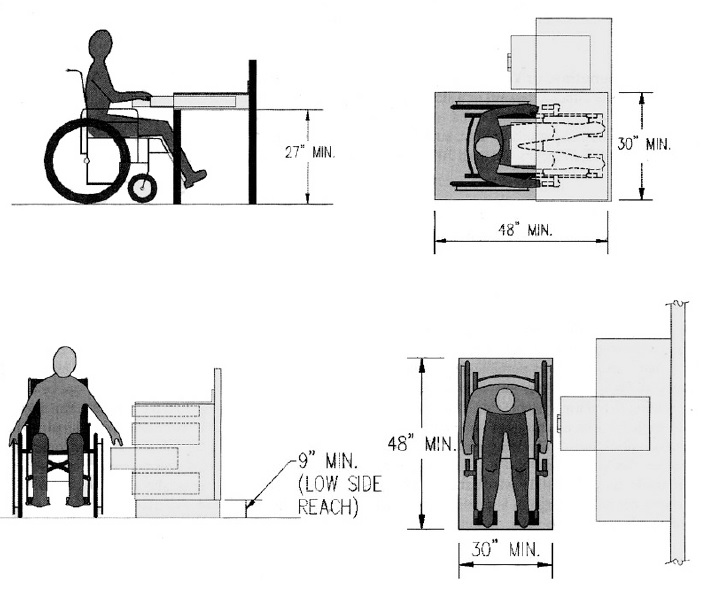
Controls [9.2.2(5)]
All controls in accessible units, sleeping rooms, and suites must comply with 4.27, which provides specifications for clear floor space, height of operable controls, and operation (see pages 96 and 97). These requirements apply primarily to those controls and operating mechanisms intended for use by patrons; those used only by employees and facility operators for purposes of maintenance or repair and similar purposes (electrical outlets for cleaning equipment, refrigerators, and clocks, etc.) are not required to comply.
Accessible Spaces [9.2.2(6)]
Where provided in accessible units, sleeping rooms, or suites, the following spaces are required to be accessible and be on an accessible route: living areas, dining areas, at least one sleeping area, patios, terraces, or balconies, bathrooms, and carports, garages, or parking spaces.
Bathrooms
Accessible bathrooms must provide an accessible water closet, accessible lavatory, and accessible shower or tub. If only half baths are provided, accessible fixtures are required in at least the one half bath required to be accessible. ADAAG allows provision of either tubs or showers in most accessible rooms. Some rooms in larger facilities must have a combination roll-in/ transfer shower. ADAAG covers several types of shower stall designs: roll-in, transfer, and, in hotels, a combination of the two. Typically a shower chair, a mobility aid more suitable for bathing than standard wheelchairs, is used with roll-in showers. Roll-in showers are most practical where shower chairs can be made readily available or where people may stay for extended periods (dormitories, dwelling units). The required folding seat in combination roll-in/ transfer showers offers greater flexibility by allowing transfer as well, particularly for people traveling without a shower chair. Two types of design for this combination shower are provided in ADAAG (Figure 57).
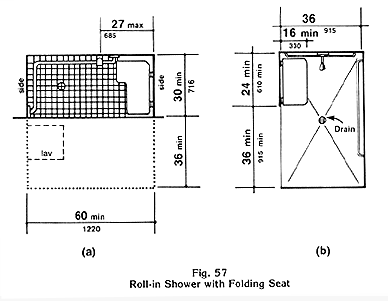
Kitchens, Kitchenettes, or Wet Bars [9.2.2(7)]
Clear floor space for either a forward or a side approach is permitted for cabinets, counters, sinks, and appliances. A forward approach to sinks (with knee and toe clearances below) is recommended for sinks that may be used more regularly or for extended periods of time, such as a kitchen in apartment-style dormitories. Counter tops and sinks may be no higher than 34 inches. At least 50% of refrigerator and cabinet shelf space must be within the reach ranges specified in 4.2.5 or 4.2.6.
Accommodations for Persons with Hearing Impairments [9.2.2(8)]
Accessible rooms or suites must also provide accommodations for people with hearing impairments (visual alarms and notification devices, volume controls on permanently installed telephones, etc.). This is required in order to accommodate a person (or couple or family) who needs both types of access. Additional portions of rooms or suites are required to provide accommodations only for persons with hearing impairments.
Visual Alarms, Notification Devices and Telephones [9.3] Auxiliary Alarms
A portion of sleeping units in transient lodging facilities must have a visual alarm connected to the building alarm system or have an outlet for a portable device. Portable devices must be capable of being triggered by the building emergency alarm system. Appliances connected to the building system, where permitted by code, can be monitored by the building fire alarm system. Portable units have to be activated by a signal from the central alarm control system, transmitted to a receiver plugged into an electrical outlet. Note that there are operational considerations in making portable appliances available on an as-needed basis. Where portable devices are used, it is important that the appliance be checked to make sure it is functioning properly, and that correct and appropriate connections and placement are made, a responsibility which should not be left solely to guests or tenants who need the device. Because guest room sizes are not large, it is required only that the signal, which is intended to alert persons who are awake, be visible in all areas of the room or unit.
Visual Notification Devices
Care must be taken that notification devices intended to signal a door knock or bell are separately wired. Like auxiliary alarms, these devices can be portable and made available as needed. In this case, ADAAG requires appropriate outlets and wiring.
Phones
Permanently installed telephones must be equipped with a volume control. An accessible electrical outlet within 4 feet of a phone connection is required to facilitate use of a portable text telephone (or TTY). (Facility operators are responsible for making portable TTYs available under ADA requirements that call for the provision of "auxiliary aids.") TTYs at hotel front desks will allow guests using TTYs in their room to access in-house services.
Social Service Establishments [9.5]
Section 9.5 provides requirements specific to halfway houses, homeless shelters, and group homes because they are a form of transient lodging and often designed for communal living. Where appropriate, scoping for accessible rooms can be applied to the number of beds. Alterations provisions recognize unique problems that may arise when shelters and similar facilities are placed in existing facilities designed for other purposes.

User Comments/Questions
Add Comment/Question